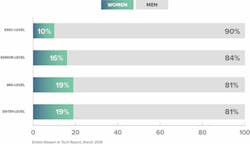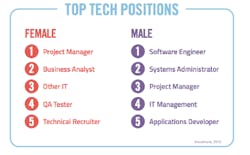Is Workplace Equity Just Lip Service?
Joanna Webb is a researcher and consultant. She has more than 6 years of experience in organizational development. For more information, please email [email protected].
In the last couple of decades, the world has made huge strides when it comes to women involvement in the workforce. According to a report by Catalyst, women make up nearly half (46.9%) of the total workforce.
Despite all the progress that has been made by women, things do not look so rosy when it comes to the tech industry. For decades, careers in the tech industry and other STEM fields have not been so welcoming to women. There is a huge gender gap between men and women in the STEM fields. This gap manifests itself through various aspects, including employment opportunities, wages, leadership opportunities, perception at the workplace, and so on.
In this article, we look at some of the latest stats to give us a better picture of the state of affairs for women in tech today.
WOMEN HOLD ONLY A QUARTER OF ALL TECH JOBS
Ever wondered how many women work in the tech industry?
According to Adeva IT, as of 2018, women held only 25% of all the jobs in the tech industry, despite women making up almost half of the total workforce. What’s worse, this number is lower than the percentage of tech jobs held by women back in the 1980s.
GIRLS ARE LESS LIKELY TO STUDY STEM SUBJECTS
One of the reasons why there is a lower percentage of women working in the tech industry compared to other industries is that girls are less likely to study STEM subjects compared to boys. According to a Women In Tech report by PWC, among the students participating in the research, more boys opted for STEM subjects compared to girls, except for biology. This is true both in high school and in university.
- According to the research, 83% of boys in high school opt for STEM subjects, while only 64% of girls opt for STEM subjects.
- The report also found that 17% of boys study physics, compared to just 7% of girls.
- The same gender disparity is evident at the university, where 52% of males take STEM related courses, in contrast to only 30% of females.
- The gap is even bigger when it comes to courses like engineering. 13% of the surveyed male university students were taking engineering courses, compared to just 2% of female university students.
There are a number of reasons why girls are less likely to study STEM subjects compared to boys.
- According to the report, some girls avoid STEM subjects because they feel that they are better in humanities and other essay based subjects.
- Others avoid STEM subjects because they do not find them interesting.
- Some girls also avoid STEM subjects because they don’t consider them to be relevant to the career paths they intend to choose.
- Other reasons include the need to get the highest grades they can to increase their chances of university placement (STEM subjects are considered to be harder) and teachers making STEM subjects appear unappealing.
The report also found that the intended career choice has varying influence on choice of A-Level subjects between boys and girls. 53% of girls choose their A-Level subjects based on their preferred career, compared to just 43% of boys.
This means that while girls are more likely to think ahead when choosing their A-Level subjects, a significant number of them avoid STEM subjects because they don’t see themselves following a career in technology.
MORE THAN TWO THIRDS OF FEMALES DO NOT CONSIDER A CAREER IN TECH
The gender disparity that starts in high school and university becomes even more pronounced when it comes to making career choices.
- The research by PWC reports that of all the female respondents, only 27% said that they would consider a tech career.
- This is in contrast to 62% of males. In addition, only 3% of females would opt for a tech career as their first choice, in contrast to 15% of males.
There are a number of reasons why females are less likely to consider a career in tech.
- First, many females do not consider a tech career because it is not being put forward as one of the options they can take.
- Whereas 33% of male respondents reported that they had someone suggest a tech career to them, only 16% of females reported to have received similar suggestion.
- The fact that careers in tech are not suggested to females helps to further the stereotype that the tech industry is a man’s world.
- In addition, many females are less likely to consider a career in tech because they don’t have enough information about what working in the technology industry entails.
Another reason why females are less likely to consider a career in the tech industry is that there are not enough female role models within the industry. When asked to name someone they would like to emulate in their future careers, 34% of the respondents had no trouble naming a successful person in the industry they were interested in. Most importantly, there wasn’t any significant disparity in the genders of the named personalities.
- Yet when the respondents were asked to name someone that inspired them to follow a career in the tech industry, 83% of female respondents were unable to name someone.
- In contrast, only 59% of male respondents were unable to name someone.
- In addition, when the respondents, both male and female, were asked to name a famous man in the tech industry, 66% were able to do it.
- However, when the question was flipped and they were asked to name a famous woman in the tech industry, only 22% could do it.
This shortage of female role models in the tech industry also helps to reinforce the perception that careers in the tech industry are generally not for women.
Women have actually been the brains behind some of the biggest achievements within the industry. Unfortunately, their contributions have gone unrecognized in most cases. In some cases, men have even taken credit for the achievements of women.
For instance, the Electrical Numerical Integrator and Computer (ENIAC) – the world’s first electric computer, which was used during The Second World War – was programmed by six women. However, these women were given no credit for their work, despite the fact that ENIAC couldn’t have worked without their contribution. Instead, they were only referred to in photos as "models." They weren’t even considered important enough to be invited to the ENIAC project’s 50th anniversary celebrations.
Such cases of the efforts of women in the tech industry going unrecognized have led to the perception that women have not made any significant contributions, hence the lack of female role models.
Additional highlights from the report include:
- WOMEN ARE MORE LIKELY TO QUIT TECH INDUSTRY JOBS
- EQUALITY DECREASES WITH RISE IN SENIORITY
According to a report by Entelo, there are about 19% of women in entry level and mid-level roles in the tech industry. At the senior level, however, women hold only 16% of positions. As you go even higher, this number drops even lower, with women holding just 10% of executive level positions.
A survey conducted by HackerRank found that 20.4% of women over the age of 35 in the tech sector remain in junior level positions, in contrast to just 5.9% of men over the age of 35. Actually, the survey found that women are more likely than men to hold junior level positions in the tech industry, regardless of their age.
Source: Entelo
- WOMEN IN THE TECH INDUSTRY EARN LESS THAN THEIR MALE COUNTERPARTS.
- WOMEN ARE MORE LIKELY TO BE PERCEIVED AS INCOMPETENT
- WOMEN ARE MORE LIKELY TO BE PUSHED TO NON-TECHNICAL ROLES
The bias against women in the tech industry can also be seen in the kind of roles women are assigned. One study found that women in the industry are more likely to be pushed into roles termed as "execution" roles, which are generally non-technical. Men, on the other hand, are more likely to be assigned the more technical "creator" roles.
For instance, the top position for women in tech is Project Manager, whereas the top position for men in tech is Software Engineer. This bias is based off the stereotype that women are not good in technical roles.
Top 5 Tech Occupations for Women and Men (Source: Fairy Good Boss)
WHAT DO THESE STATS MEAN?
The stats shown earlier show that despite all the huge strides that have been made in regards to representation of women in the workforce, there is still a lot of inequality in the tech industry. What’s more, it doesn’t look like this inequality will end any time soon.
In addition, the world is at a point in time where most aspects of our working and personal lives are becoming shaped by technology. Unfortunately, the low number of women in tech means that most tech products and services are designed from the male perspective and to meet the needs of male users, even if they are meant to be used by both men and women. The key to making the needs of women met when designing and building tech products and services is to bring more women aboard in the tech industry.
Finally, the gender gap in the tech industry means that women are not getting enough opportunities to play a part in shaping the future of society.
THE WAY FORWARD
Having established that there is a huge gender gap, there are a number of steps that can be taken to increase the number of women working in the tech industry. These include:
- The Industry Should Get Involved in Educating Students About Tech and Its Role in Shaping the World
- Increased Access to Tech Careers
- Increased Visibility of Female Role Models in the Industry
The best way to get females interested in tech careers is to show them that tech is not a male dominated field, and the most-effective way of doing this is by increasing the number of visible female role models in the industry. Fortunately, women are increasingly holding the top and highly visible positions in big tech companies. Some high-profile women in tech include:
- Facebook COO Sheryl Sandberg
- YouTube CEO Susan Wojcicki
- IBM CEO Ginni Rometty
- Former Yahoo CEO Marissa Mayer
- Former Hewlett-Packard CEO Meg Whitman
More Should Be Done To Help Women in the Industry Reach Their Full Potential
We saw that there is huge inequality against women who are already working in the tech industry.
- They are paid less than their male counterparts,
- they are passed over for promotions,
- they are pushed to non-technical roles, and so on.
Why bother majoring in software engineering if you will end up being a project manager anyway?
If more women are to join the tech industry, tech companies need to do more to create a level playing field for women.
Ditch the Damaging Dialogues
If you work in the tech industry, you have probably heard someone say something like this to a woman: "For a woman, you are really skilled at this," or "You are too beautiful for an engineer."
Unfortunately, these seemingly harmless comments help reinforce the stereotype that the tech industry is a man’s world. For instance, by telling a woman that she’s really skilled at something, it shows that you believe that men are generally better at the said task. Which means that if you had to choose between a man and a woman to perform the task, you would probably choose the man.
See the bias? For this to stop, people (both male and female) in the tech industry have to learn to ditch such seemingly benign comments that nevertheless perpetuate the stereotype that tech is a male-dominated field.
WRAPPING UP
The numbers listed above make it clear that despite all the progress that has been made in the last couple of decades, the tech industry is still a "boys only" club.
Women are still underrepresented in the industry, and there is still a lot of inequality against women.
Still, there are some steps that can be taken to remedy this, including
- educating students about tech and its role in shaping the world,
- increasing access to tech careers,
- increasing visibility of female role models in the industry,
- leveling the playing field for women to enable them achieve their full potential, and
- ditching damaging dialogues that perpetuate the stereotype that tech is a man’s world.
About the Author
Martin Luenendonk is CEO and Co-Founder of Cleverism.com.


